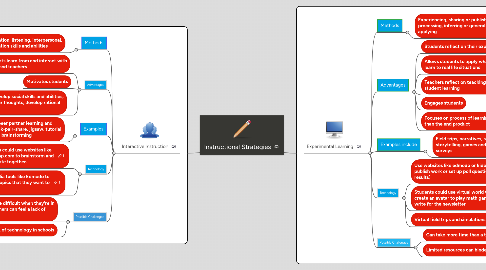
1. Experimental Learning
1.1. Methods
1.1.1. Experiencing, sharing or publishing, analyzing or processing, inferring or generalizing, and applying
1.2. Advantages
1.2.1. Students reflect on their experience
1.2.2. Allows students to apply what they learn to real life situations
1.2.3. Teachers reflect on teaching and student learning
1.2.4. Engages students
1.2.5. Focuses on process of learning rather than the end product
1.3. Examples include
1.3.1. Field trips, narratives, simulations, storytelling, games and role-playing, surveys
1.4. Technology
1.4.1. Use websites like edmodo or kidblog to share and publish work or set up poll questions (students can see results)
1.4.2. Students could use virtual world websites like Whyville to create an avatar to play math games, vote on town issues, write for the newsletter
1.4.3. Virtual field trips and simulations
1.5. Possible Challenges
1.5.1. Can take more time than a typical lesson
1.5.2. Limited resources can hinder opportunities
2. Interactive Instruction
2.1. Methods
2.1.1. Observation, listening, interpersonal, intervention skills and abilities
2.2. Advantages
2.2.1. Students learn from and interact with peers and teachers
2.2.2. Motivates students
2.2.3. Students develop social skills and abilities, organize their thoughts, develop rational arguments
2.3. Examples
2.3.1. Debates and discussion, peer partner learning and cooperative learning, think-pair-share, jigsaw, tutorial groups and conferencing, brainstorming
2.4. Technology
2.4.1. Students could use websites like groupmap.com to brainstorm and collaborate together.
2.4.2. Students can also use social media tools like Edmodo to answer poll questions and post topics that they want to discuss with others.
2.5. Possible Challenges
2.5.1. Managing students can be difficult when they're in different places and teachers can feel a lack of control
2.5.2. Lack of technology in schools
